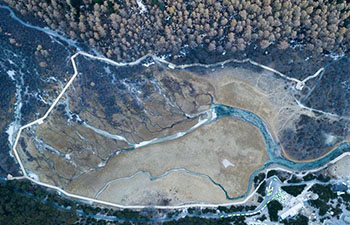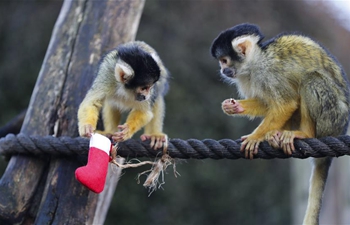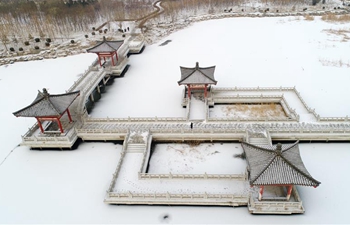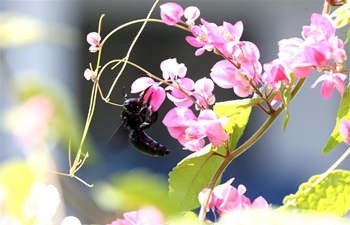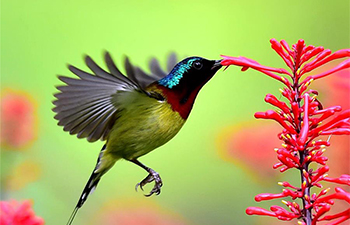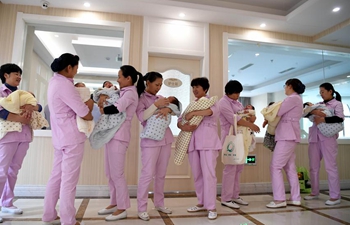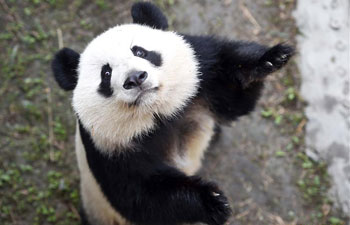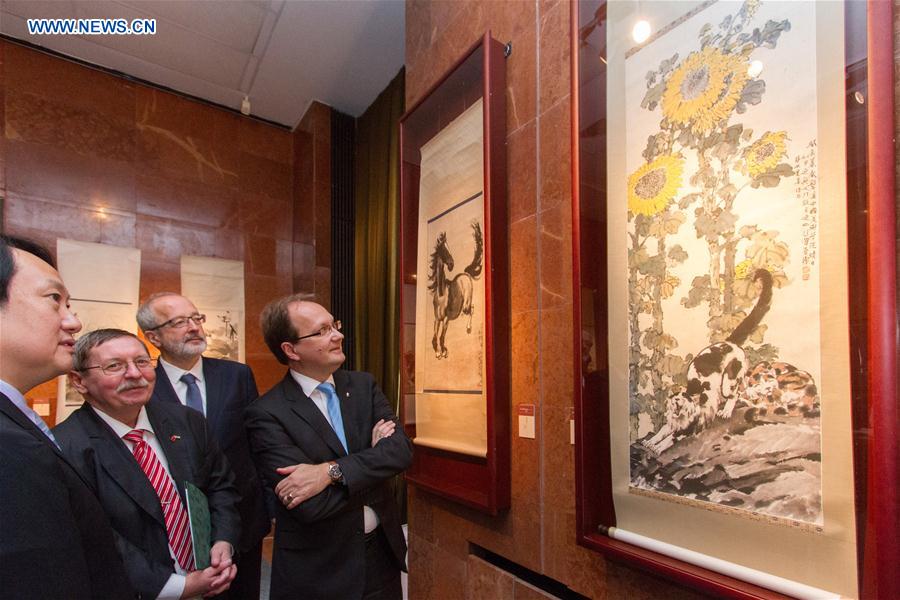
Peter Hoppal (1st R), State Secretary for Culture at the Ministry of Human Resources of Hungary, and Liao Honghua (1st L), the secretary general of the Xu Beihong Art Committee, look at Xu Beihong's paintings on the exhibition in Budapest, Hungary, on Dec. 14, 2017. A new artistic exhibition entitled "Cultures and Generations: Founders and Heirs of Chinese and Hungarian Modern Art" has been launched here on Thursday featuring nearly 100 paintings and sculptures at the National Szechenyi Library in the Hungarian capital Budapest. (Xinhua/Szilard Voros)
BUDAPEST, Dec. 14 (Xinhua) -- A new artistic exhibition entitled "Cultures and Generations: Founders and Heirs of Chinese and Hungarian Modern Art" has been launched here on Thursday featuring nearly 100 paintings and sculptures at the National Szechenyi Library in the Hungarian capital Budapest.
"In recent years, the cultural cooperation between China and Hungary has been intensified in many areas, and in this context, many cultural events came true," Peter Hoppal, State Secretary for Culture at the Ministry of Human Resources of Hungary said at the opening ceremony of the exhibition.
"The close cultural relations that go hand in hand with the ever-expanding economic cooperation, are young but intense," Hoppal pointed. "This development is the result of the Eastern opening policy of the Hungarian government, which is linked to the One Belt, One Road cooperation," he added.
"China's thousands of years of culture, its insightful philosophy-based decorative art has always been exciting for the Hungarians who are nowadays more and more eager to learn Chinese as well," he underlined.
And on the other hand, China is also happy to discover Hungarian art, as it has done recently with Hungarian painter Mihaly Munkacsy's paintings or the treasures of the Hungarian National Museum presented in their country, Hoppal concluded.
"The central figure of the exhibition, Xu Beihong, studied in Europe in his younger age, and brought back the quintessence of European art with him to China, combining them with local art traditions," Chinese Ambassador to Hungary Duan Jielong declared. "His special style had a great impact on the generations following him," he added.
He pointed: "The Sino-Hungarian relations blossom in ways never seen before, including cultural cooperation."
"The Chinese premier recently visited Budapest, where he met with 16 heads of state of Central and Eastern Europe, including Hungarian Prime Minister Viktor Orban, giving a new stimulus to Sino-Hungarian cooperation," the high ranking diplomat recalled.
"Xu Beihong organized a large-scale exhibition of more than 300 Chinese paintings ranging from the Tang and Song dynasties to modern times in 1933-34, which he brought to five major cities in Europe. Chinese paintings, including from the Tang and Song dynasties until modern times",said Liao Honghua, the secretary general of the Xu Beihong Art Committee.
"Today, we feel more profoundly that only mutual recognition of culture and arts can enable us to cooperate better and develop better," Liao said.
The exhibition of nearly 100 paintings and sculptures, not only draws a parallel between the Hungarian and Chinese creators and works, but also sheds a light on the relationship between the master and the disciple including its role in the two different cultures.
In addition to the works of Xu Beihong, the father of modern Chinese painting and the works of the school he created, the Hungarian artists belonging to the same generation, Bertalan Szekely, Istvan Csok, Istvan Szonyi, Peter Menasagi, Frigyes Konig and Jozsef Szurcsik will be also displayed until Jan. 12, 2018.
The exhibition was organized by Xu Beihong Art Committee, the National Szechenyi Library, the Hungarian University of Fine Arts and the Sino-European Foundation for Culture and Education.





